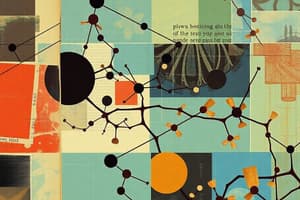Podcast
Questions and Answers
What does the term 'drug dose-response relationship' refer to?
What does the term 'drug dose-response relationship' refer to?
- The influence of the route of administration on drug effectiveness.
- The relationship between the amount of drug administered and the proportion of patients achieving a desired effect. (correct)
- The connection between side effects experienced by patients and the drug dose.
- The amount of drug needed to cause a severe adverse reaction in all patients.
Which statement accurately describes the function of an antagonist in pharmacodynamics?
Which statement accurately describes the function of an antagonist in pharmacodynamics?
- An antagonist always produces a more potent effect than an agonist.
- An antagonist binds to the receptor and produces a biological response.
- An antagonist blocks the action of an agonist at the receptor site. (correct)
- An antagonist enhances the effect of the drug on the receptor.
What does the concept of drug-receptor affinity refer to?
What does the concept of drug-receptor affinity refer to?
- The ability of a drug to elicit a high therapeutic index.
- The strength of binding between a drug and its receptor. (correct)
- The likelihood of a drug causing adverse effects based on dosage.
- The tendency of a drug to cause inter-patient variability in response.
How is the therapeutic index defined in pharmacodynamics?
How is the therapeutic index defined in pharmacodynamics?
What factor contributes to inter-patient variability in drug responses?
What factor contributes to inter-patient variability in drug responses?
What is the primary role of agonists in drug-receptor interactions?
What is the primary role of agonists in drug-receptor interactions?
How is the therapeutic index defined?
How is the therapeutic index defined?
Which of the following factors can influence interpatient variability in drug responses?
Which of the following factors can influence interpatient variability in drug responses?
What is indicated when a drug has a high therapeutic index?
What is indicated when a drug has a high therapeutic index?
What characterizes an antagonist in drug-receptor interactions?
What characterizes an antagonist in drug-receptor interactions?
If a patient has a lower ED50, how does it affect their response to a drug?
If a patient has a lower ED50, how does it affect their response to a drug?
Which of the following is NOT an example of a drug that operates without involving receptors?
Which of the following is NOT an example of a drug that operates without involving receptors?
When evaluating the dose-response curve of a drug, what does an upward shift indicate?
When evaluating the dose-response curve of a drug, what does an upward shift indicate?
What does the dose-response relationship indicate?
What does the dose-response relationship indicate?
Which phrase accurately depicts maximal efficacy in drug therapy?
Which phrase accurately depicts maximal efficacy in drug therapy?
What is true about interpatient variability in drug responses?
What is true about interpatient variability in drug responses?
Which drug is recommended for treating a mild headache based on efficacy?
Which drug is recommended for treating a mild headache based on efficacy?
What is a primary consideration when adjusting drug dosages?
What is a primary consideration when adjusting drug dosages?
Which of the following best describes the therapeutic index?
Which of the following best describes the therapeutic index?
What is the significance of drug-receptor interactions in pharmacodynamics?
What is the significance of drug-receptor interactions in pharmacodynamics?
In a dose-response curve, what does a higher curve indicate?
In a dose-response curve, what does a higher curve indicate?
Flashcards are hidden until you start studying
Study Notes
Pharmacodynamics
- The study of what drugs do to the body and how they do it.
Dose-Response Relationship
- The relationship between the size of an administered dose and the intensity of the response produced.
- Determines how much we need to increase the dosage to produce the desired increase in response.
Drug-Receptor Interactions
- Agonists: Drugs that bind to receptors and mimic the actions of endogenous substances.
- Antagonists: Drugs that bind to receptors but do not elicit a response. They block the effect of the agonist.
The Therapeutic Index
- A measure of a drug’s safety.
- Ratio of the drug’s LD50 (average lethal dose) to its ED50 (average effective dose).
- The larger the therapeutic index, the safer the drug.
- The smaller the therapeutic index, the less safe the drug.
Maximal Efficacy
- The maximum response a drug can produce.
- Match the intensity of the response with the patient’s need.
- Very high maximal efficacy is not always more desirable.
Interpatient Variability in Drug Responses
- The dose required to produce a therapeutic response can vary among patients.
- Variables that can influence drug response include age, physiological function (heart, liver, kidneys), disease state, vascular status, and nutrition.
- The initial dose of a drug is an approximation and subsequent doses may need to be increased or decreased after the patient response is evaluated.
Drug Responses that Do Not Involve Receptors
- Simple physical or chemical interactions with other small molecules.
- Examples include antacids, antiseptics, and saline laxatives.
Studying That Suits You
Use AI to generate personalized quizzes and flashcards to suit your learning preferences.




